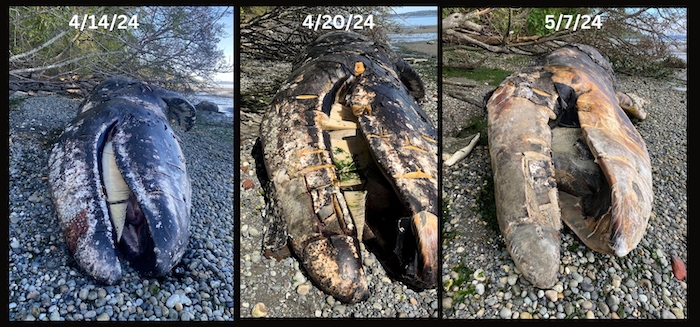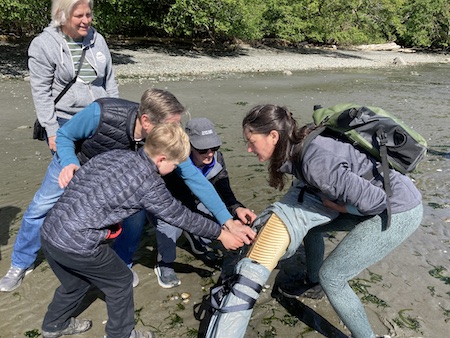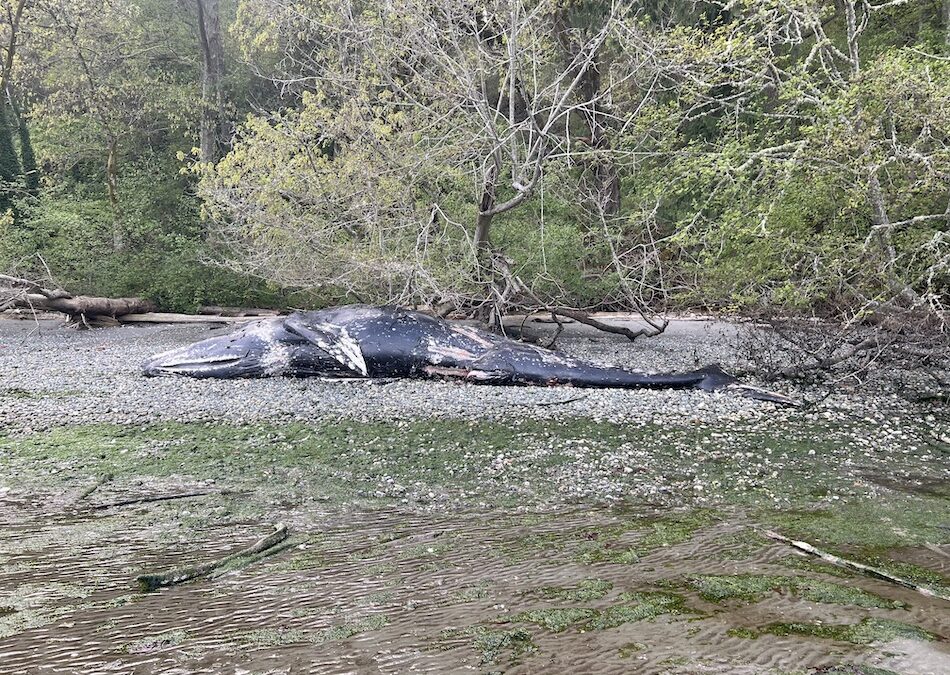By: Kathyrn True, Taylor Umetsu, Santiago Ramos-Torrescano
This is the first in a VNC blog series delving into various aspects of island biodiversity. Vashon Nature Center’s vision statement is “A world awakened to the wonders of nature.” We hope this ongoing exploration will raise awareness of our role as humans in fostering healthy island ecosystems, inspiring both awe and action.
When Beth Nauman-Montana’s friend told her that a deceased gray whale had washed ashore on an eastside island beach, she made plans to visit immediately. An amateur naturalist and avid beach explorer, Nauman-Montana recognized this rare opportunity and headed to the site that afternoon with her husband and one of her teenage sons.
“We were there by ourselves—it was just our family and the whale,” she says. “There was a sense of quietness—there’s no better word to describe it. It was a unique experience and felt like a privilege to be there.”
Though the whale was obviously dead, Nauman-Montana could see barnacles moving on its body and “hundreds, if not thousands” of whale lice (nickel-sized crustaceans that live on whales) dotting its surface. The whale’s mouth was open, and she could hear something splashing around inside its body—possibly a stranded fish that had sought refuge in a “cave” at high tide? Nauman-Montana was impressed by the bright white of the animal’s baleen, and describes a briny scent, not of death, more like the shore at low tide. Its appearance and death inspires sadness and reverence, awe, and curiosity—and it also reminds us that the whale itself is home to a diverse ecosystem.
Gray whales are known for their epic migrations, traveling more than 10,000 miles from their southern breeding grounds in Baja California to their northern feeding grounds in the Arctic. During this arduous journey, a small group of about 20 whales make a pit stop in Puget Sound to replenish their energy reserves with ghost shrimp. These whales, known as the “Sounders,” return to the area year after year. Some individuals, termed “stragglers,” inadvertently wander into the Sound and sadly have a high rate of mortality due to starvation and ship strikes.
According to Jessie Huggins of Cascadia Research Collective, an Olympia-based research group whose focus includes whales, the adult male gray whale that landed on Vashon was not one from their Sounders’ catalog and had been spotted in poor condition a few weeks prior to the stranding. A necropsy determined that there were no signs of past or present entanglements, killer whale bites, or significant blunt- force trauma. Internally, the examination revealed an empty gastrointestinal tract, atrophied muscles, and severely depleted blubber lacking in oil, confirming the emaciated nutritional status of the whale.
As most gray whales are, this male was host to countless whale barnacles of the species Cryptolepas rhachianecti. Individual gray whales are known to carry up to 1,000 pounds of them! The barnacles in turn house parasitic whale lice, the crab-like creatures that Nauman-Montana observed. Though they have been known to irritate whales, who sometimes rub themselves in sediment to remove them, they also help the whale stay healthy by eating the skin around wounds, thus reducing the whale’s risk of infection.

On land, the whale has now transformed from a seafaring ecosystem to a land-based one. Even after they die, stranded marine mammals are an important part of the food web. They provide a feast of food for both terrestrial and marine life, from large scavengers like coyotes, birds, and crabs all the way down to microscopic organisms that feed on decomposing tissues. Additionally, large mammals like this whale release a significant amount of organic matter and nutrients into the environment, enriching the surrounding ecosystem.
Huggins estimates it will take around 4 months for the whale that landed on Vashon to be reduced to mostly skeletal material. But this will depend on scavengers in the area, temperatures, and a variety of other factors. When stranded, whales are typically transported by humans to deeper waters and then purposefully sunk or they are towed to less populated areas to avoid conflicts with human residences. This whale washed up on a King County protected area and far from human inhabitants and so the decision was made to leave the whale on the shore, where it washed up naturally. This presents a unique and rare opportunity for learning. To get an idea of the decomposition process, Vashon Nature Center has installed motion-sensing wildlife cameras to document visits from scavengers. So far, cameras have recorded a coyote tearing off parts of blubber, a curious mouse scurrying up to the whale for a meal, and a blue heron taking advantage of the protected pool formed behind the whale’s body to hunt for fish. Check out our youtube playlist here for these and other whale cam videos.

Vashon Nature Center received permission from NOAA to collect the whale’s bones. Center staff are making plans to work with local schools and community volunteers to articulate (recompose) the whale’s skeleton and display the skeleton somewhere on the island.
“ We are grateful to have received this opportunity from NOAA,” says Bianca Perla, VNC Science Director, “this is a rare occurrence that we can learn a lot from. We don’t know much about a whale’s role in the ecosystem after death. And, there is something incredible about being able to not only see a large animal like this up close but also to actually hold his bones and learn about the intricate way these massive creatures are put together and how their bodies are so efficient for life at sea. While it is sad that he died, his death can be a gift that inspires awe for life’s complexity and respect for his species. We can all benefit from those feelings. We envision this opportunity as offering a rare glimpse into the life of one of the magnificent creatures we share our waters with.”

To accomplish this, we hope to involve many of you! We are seeking Whale Ambassadors, volunteers to assist with daily checks on the whale, and individuals who can help with bone collection and storage. We welcome assistance from kayakers, boaters, and those with expertise in butchery and bone cleaning, as well as anyone with extra storage space. If interested, please contact VNC Research and Program Associate, Taylor Umetsu at taylor@vashonnaturecenter.org.
As we continue to learn from this great creature, it’s awe-inspiring to reflect on how its life on sea and now death on land brought and brings sustenance to likely millions of creatures. We honor this whale, an apt being to open our minds to the whale-sized topic of biodiversity.
MARINE MAMMAL ETIQUETTE:
- If you come across a stranded marine mammal, you can report it to the West Coast Stranding hotline at 1-866-767-6114, or find the local responder on the map here. Vashon Island’s local responder is Cathy King at World Vets, who can be reached at: 253-777-1775, or marine-mammals@worldvets.org. Please also inform local whale naturalist Orca Annie, Ann Stateler: 206-463-9041 or vashonorcas@aol.com. Please take a photo of the animal and get a GPS location if you can. This documentation is crucial to develop a baseline from which we can detect changes in overall numbers of strandings, distribution, seasonality, species, or age classes.
- Remember that all marine mammals, even dead ones, are protected by the Marine Mammal Protection Act. Please do not take parts from the stranded whale on Vashon. Itis illegal to do so and it will compromise the benefit to the community if pieces are missing from the skeleton as we work to rebuild it.
Feature photo: An adult male gray whale (Eschrichtius robustus) washed up on an island beach on April 13, 2024. Photo by: Beth Nauman-Montana


I came upon the whale by myself with my dog on the afternoon of April 12. It was out on the flat tide lands. I will never forget this incredible once in a lifetime experience. I walk this beach every day so you will see me and my dog quite regularly on the camera. Let me know if you want me to check on anything! We live by the big rock between the whale and Klahanie.
That must have been an amazing experience Laura. And thanks for the offer. Nice to know you are close and we will keep that in mind as it may come in handy to have someone who can get there fast at some point.
Great project. Congratulations.
You may be familiar with Lee Post, Homer, AK :
https://www.theboneman.com/abouttheauthorleepost
email address : boneman@xyz.net
Check out his books on rearticulation of skeletal material (including whales). Perhaps get in touch with him : he is very helpful and available for assistance, if needed.
Christian, thanks so much for this resource!